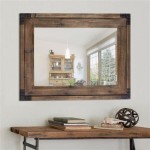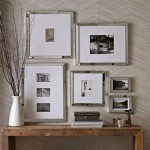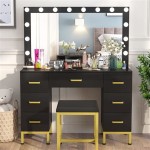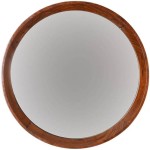How To Hang a Heavy Mirror Securely On a Wall
Hanging a heavy mirror can significantly enhance the aesthetic appeal of a room, adding light and creating a sense of spaciousness. However, the weight of such mirrors necessitates careful planning and execution to ensure they are hung safely and securely, preventing damage to the mirror, the wall, and potentially, individuals. This article provides a comprehensive guide on how to hang a heavy mirror on a wall, focusing on the necessary preparations, the identification of wall types, the selection of appropriate hanging hardware, and the step-by-step installation process.
Identifying the Wall Type and its Load-Bearing Capacity
Before attempting to hang a heavy mirror, accurately identifying the wall type is paramount. The wall type dictates the appropriate hanging hardware and the maximum weight it can safely support. Common wall types encountered in residential and commercial buildings include drywall, plaster, concrete, and brick. Each wall type requires a specific approach regarding anchor selection and installation techniques.
Drywall, often used in interior walls, is relatively weak and cannot support significant weight using standard nails or screws. Plaster, while generally stronger than drywall, can be prone to crumbling if not handled carefully. Concrete and brick walls, on the other hand, are significantly stronger and can support much heavier loads, but they require specialized drilling equipment and anchors designed for masonry.
Determining the wall type can be achieved through a few methods. A simple visual inspection can often differentiate between drywall and plaster. Drywall typically has a smooth, uniform surface, while plaster may have a slightly textured or uneven finish. Tapping on the wall can also provide clues. Drywall tends to sound hollow, while plaster, concrete, and brick will produce a more solid sound. For confirmation, a small, inconspicuous hole can be drilled to reveal the wall's composition. Wear a mask and safety glasses when drilling any material.
Once the wall type is identified, assess its load-bearing capacity. Drywall, even with appropriate anchors, generally cannot support mirrors exceeding 50 pounds. Plaster might handle slightly more weight, but caution is still advised. Concrete and brick walls can support much heavier mirrors, but it's crucial to use anchors rated for the specific weight of the mirror and the type of masonry.
If unsure about the wall's load-bearing capacity, consulting a professional contractor or structural engineer is recommended. They can assess the wall's construction and provide guidance on safe weight limits and appropriate hanging methods.
Selecting the Appropriate Hanging Hardware
Choosing the correct hanging hardware is crucial for the safe and secure installation of a heavy mirror. The selected hardware must be compatible with the wall type and rated to support the mirror's weight with a significant safety margin. Using inadequate hardware can lead to the mirror falling, causing damage and potential injury.
For drywall, several types of anchors are available, each with different weight capacities. Toggle bolts are among the strongest and most reliable drywall anchors. They consist of a screw and a spring-loaded wing that expands behind the drywall, providing a secure hold. Molly bolts are another option, featuring a sleeve that expands as the screw is tightened, gripping the drywall. Self-drilling drywall anchors, also known as wall anchors or EZ anchors, can be screwed directly into the drywall without pre-drilling, but they generally have lower weight capacities compared to toggle bolts and molly bolts. Always check the manufacturer's weight rating and select anchors that exceed the mirror's weight by at least 25%.
Plaster walls can be more challenging due to their tendency to crumble. Using anchors specifically designed for plaster is essential. Plaster anchors, often made of plastic or metal, have a wider flange that distributes the weight over a larger area, preventing damage to the plaster. Toggle bolts and molly bolts can also be used in plaster, but care must be taken to drill the correct size hole and avoid over-tightening, which can crack the plaster. Consider using a plaster washer behind the anchor to further distribute the weight.
For concrete and brick walls, masonry anchors are required. These anchors are designed to grip the hard surface of the masonry. Sleeve anchors are a common choice, consisting of a bolt surrounded by a sleeve that expands when tightened. Wedge anchors are another option, using a wedge-shaped clip to secure the anchor in the hole. Tapcon screws are self-tapping concrete screws that can be drilled directly into concrete or brick without pre-drilling, but they are best suited for lighter loads. When selecting masonry anchors, ensure they are rated for the specific type of masonry and the weight of the mirror.
In addition to anchors, appropriate hanging hardware for the mirror itself is necessary. D-rings or wire are commonly used to attach the mirror to the wall. D-rings should be securely attached to the mirror frame with screws or bolts. The wire should be heavy-gauge and capable of supporting the mirror's weight. Ensure the wire is securely fastened to the D-rings and that there is minimal slack. French cleats offer a very secure way to hang heavier mirrors. A French cleat consists of two interlocking pieces of wood or metal, one attached to the wall and the other to the back of the mirror.
When purchasing hanging hardware, always choose high-quality materials from reputable manufacturers. Avoid using cheap or flimsy hardware, as it may fail under the weight of the mirror. Read the manufacturer's instructions carefully and follow them precisely.
Step-by-Step Installation Process
The installation process for hanging a heavy mirror involves careful planning, precise measurements, and the correct use of tools and hardware. Following these steps will help ensure a safe and secure installation.
1.
Preparation:
Gather all the necessary tools and materials. This includes the mirror, hanging hardware (anchors, screws, D-rings, wire, or French cleats), a drill with appropriate drill bits for the wall type, a level, a stud finder (if applicable), a measuring tape, a pencil, safety glasses, and a dust mask. Protect the floor with a drop cloth or old blanket.2.
Locate Wall Studs (If Applicable):
If possible, locate wall studs behind the drywall or plaster. Securing the mirror to a stud provides the strongest possible support. Use a stud finder to locate the studs and mark their location with a pencil. If the mirror's hanging points align with a stud, using screws directly into the stud is the preferred method. Avoid using a stud finder on concrete or brick walls as they are inherently solid.3.
Mark the Hanging Location:
Determine the desired location for the mirror on the wall. Use a measuring tape and level to ensure the mirror will be hung straight and at the correct height. Mark the location of the hanging points on the wall with a pencil. If using wire, measure the distance between the top of the mirror frame and the wire when the mirror is hanging, then transfer that measurement to the wall to mark where the anchor should be placed. This ensures the mirror hangs at the desired height.4.
Drill Pilot Holes:
Using the appropriate drill bit for the wall type and anchor size, drill pilot holes at the marked locations. For drywall and plaster, start with a smaller drill bit and gradually increase the size until it matches the anchor's requirements. For concrete and brick, use a masonry drill bit and drill slowly and steadily, applying consistent pressure. Wear safety glasses and a dust mask to protect your eyes and lungs from debris. Be sure to drill straight into the wall and not at an angle.5.
Install Anchors:
Insert the selected anchors into the pilot holes. For toggle bolts, fold the wings of the toggle and insert them through the hole. Once the wings are behind the wall, they will spring open. Tighten the screw to secure the anchor. For molly bolts, insert the bolt through the mirror's hanging hardware and into the anchor. Tighten the bolt to expand the sleeve behind the wall. For masonry anchors, follow the manufacturer's instructions for installation. This may involve hammering the anchor into the hole or tightening a nut to expand the anchor.6.
Hang the Mirror:
Carefully lift the mirror and align the hanging hardware with the installed anchors. For D-rings and wire, hang the wire or D-rings onto the hooks or screws attached to the anchors. For French cleats, align the two interlocking pieces and slide the mirror down until it is securely engaged.7.
Verify the Installation:
Once the mirror is hung, use a level to ensure it is perfectly straight. Make any necessary adjustments. Gently tug on the mirror to ensure it is securely attached to the wall. If there is any movement or instability, remove the mirror and re-install the anchors or use larger anchors.8.
Clean Up:
Remove any debris from the area and dispose of the used materials properly. Inspect the wall for any damage and repair any holes or cracks. Clean the mirror to remove any fingerprints or smudges.By following these steps carefully and selecting the appropriate hardware, a heavy mirror can be safely and securely hung on a wall, enhancing the aesthetic appeal of the room and providing years of enjoyment.

How To Hang A Large Or Heavy Mirror

How To Hang A Heavy Mirror C R F T

How To Hang A Very Heavy Picture Or Mirror The Best

How To Hang A Heavy Mirror Diy Family Handyman

A Better Way To Hang Heavy Mirror Hanging Pictures

How To Hang A Heavy Mirror With Pictures Wikihow

How To Hang A Heavy Mirror

How To Hang A Heavy Mirror

How To Hang A Heavy Mirror Or Picture True Value
:strip_icc()/ScreenShot2022-04-28at1.12.19PM-e055476c70c6438585fa7c5cd531edcf.png?strip=all)
4 Easy Ways To Hang A Heavy Mirror








